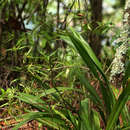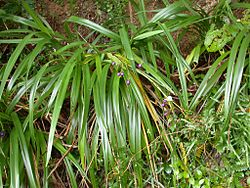pms
nòm ant ël fil


Dianella ensifolia is a flowering plant, of the family Asphodelaceae. It is native to southern China, India, Japan, Madagascar, Malesia, the Pacific Islands, Singapore, Sri Lanka, Taiwan, and tropical Asia. Its common names include umbrella dracaena, common dianella, siak-siak, and flax lily.[1]
The Dianella ensifolia’s natural habitat is terrestrial, and it can grow in grasslands, or primary rainforests in tropical areas. The plant's anatomy consists of branching rhizomes, and flowering stems, that can reach up to two meters. Its leaf blades are pointed and tapered at both ends. When flowering, it produces a shoot about 60 cm (23.6 in) long. It has white petals, with orange/yellow anthers. Once it is pollinated by insects, it will produce berries that are dark blue/purple, and about 1.5 cm (0.59 in) wide. These berries contain 3-6 seeds, that are often eaten by native birds.[1]
Other common names for the Dianella ensifolia include umbrella dracaena, common dianella, and flax lily.[1]
The Latin name Dianella is after Diana, a goddess in Greek mythology. Further, the Latin ensifolia is used to regard the sword-shaped leaves of the plant. [1]
A 2017 study investigated the roots of the Dianella ensifolia, and was able to isolate eleven compounds. These compounds were: methyl orsellinate, rhizinonic acid, 5,7-dihydroxy-2-methylchromome, 5,7-dihydroxy-2,8 dimethylchromone, (-)-4'-hydroxy-7-methoxyflavan, (-)-4'-hydroxy-7-methoxy-8-methylflavan, (2S)-30,4'-dihydroxy-7-methoxyflavan, (2R)-7,4'-dihydroxy-5-methoxy-8-methylflavan, tupichinol A, naringenin, and farrerol. When broken into groups, this would constitute two aromatics, two chromones, and 7 flavonoids.[2]
The compounds found in D. ensifolia can be correlated with different taxonomic levels, including the species, genus, and family. The research concluded the structural skeletons of the compounds found in the D. ensifolia, are found within the species of Dianella, and Liliaceae. This would correlate the species to the genus. Further, the aromatics, chromones, and flavonoids were first isolated from the species itself of the genus, and thus, could serve as markers for the identification of Dianella ensifolia.[2]
In 2020 essential oil of the D. ensifolia was chemically analyzed, and tested for its antibacterial, antioxidant, and cytotoxic properties. The main components of the plant essential oil were identified as allo-aromadendrene (7.3%), Geranylacetone (6.2%), Hexahydrofarnesyl acetone (4.4%), Longifolene (4.2%), and β-caryophyllene (4.0%).[3]
When examined individually, these compounds exhibit potent antimicrobial activity, cytotoxic activity, the potential to inhibit cell growth and proliferation, and in-vivo protective effects against juglone-induced oxidative stress in roundworm.[3]
The essential oil was investigated further for its antibacterial activity, and it was determined that it effectively inhibited the growth of numerous bacterial strains, including Bacillus subtilis ATCC 6633 and Staphylococcus aureus ATCC 6538. This effect was associated with the compounds geranylacetone, hexahydrofarnesyl acetone, longifolene, and β-caryophyllene, found in the essential oil. [3]
The cytotoxicity of the essential oil was also examined against liver hepatocellular cells, and human breast adenocarcinoma cell line. The essential oil of the D. ensifolia displayed a dose-dependent effect on both tumor cell lines. This may be contributed to the reported tumor motility inhibition, and tumor aggression inhibition of β-caryophyllene.[3]
A study conducted in 2010 screened plant extracts for antioxidants, and determined that the extract of Dianella ensifolia was both a strong antioxidant, and an agent that could be used to reduce skin hyperpigmentation. The extract of Dianella ensifolia, 1-(2,4-dihydrophenyl)-3-(2,4- dimethoxy-3-methylphenyl) propane (DP), was found to inhibit a free radical, which is linked to hyperpigmentation, and ultraviolet-C induced lipid oxidation. The extract from the plant was then tested against two pharmaceutical topical treatments. It was concluded that the plant extract, containing DP, had an increased rate of fading compared to the other treatments containing hydroquinone.[4]
Dianella ensifolia is a flowering plant, of the family Asphodelaceae. It is native to southern China, India, Japan, Madagascar, Malesia, the Pacific Islands, Singapore, Sri Lanka, Taiwan, and tropical Asia. Its common names include umbrella dracaena, common dianella, siak-siak, and flax lily.
Dianella ensifolia es una especie de planta herbácea perteneciente a la familia Xanthorrhoeaceae, en la subfamilia Hemerocallidoideae, que se encuentra en Asia.[1]
Es una planta herbácea perennifolia con rizoma rastrero, de 5-8 mm de espesor. Las hojas alargadas en forma de espada (que disminuye gradualmente en ambos extremos) tienen un tamaño de 30 a 80 cm de largo × 1 a 2,5 cm de ancho; son coriáceas, con nervio central abaxial, con el margen generalmente escabroso, y el ápice obtuso. El escapo es de 1 a 2 m de altura. Los tépalos son de color blanco, blanco verdoso, amarillento o púrpura azulado. Los estambres son más cortos que los tépalos. El fruto es en forma de bayas de color azul profundo, subglobosas, de 6 mm de diámetro.
Se encuentra en los bosques, en las laderas cubiertas de hierbas, desde el nivel del mar hasta cerca de 1700 m s. n. m. (metros sobre el nivel del mar), en Fujian, Cantón, Guangxi, Guizhou, Hainan, Jiangxi, Sichuan, Taiwán, Bangladés, Yunnan, Bután, Camboya, India, Indonesia, Japón, Laos, Malasia, Birmania, Nepal, Filipinas, Sri Lanka, Tailandia, Vietnam, África (Madagascar), Australia e islas del Pacífico].[2]
Dianella ensifolia fue descrita por (Linneo) DC. y publicado en Les Liliacees...a Paris 1(1): pl. 1, en el año 1802.[3]
Tiene un número de cromosomas de: 2 n = 32.
Dianella ensifolia es una especie de planta herbácea perteneciente a la familia Xanthorrhoeaceae, en la subfamilia Hemerocallidoideae, que se encuentra en Asia.
Dianella ensifolia est une espèce de plantes de la famille des liliacées selon la classification classique de Cronquist (1981).
Madagascar, Inde, Asie du Sud Est, Chine, Australie, Iles du Pacifique.
Dianella ensifolia est une espèce de plantes de la famille des liliacées selon la classification classique de Cronquist (1981).
Pokok Akar Siak merupakan sejenis pokok herba saka dalam keluarga Liliaceae. Nama sainsnya adalah Dianella ensifolia.
Hương bài hay còn gọi xương quạt, hương lâu, lâm nữ, cây rễ hương, cây bả chuột (danh pháp khoa học: Dianella ensifolia) là một loài thực vật có hoa trong họ Thích diệp thụ. Loài này được (L.) DC. miêu tả khoa học đầu tiên năm 1802.[1]
Hương bài hay còn gọi xương quạt, hương lâu, lâm nữ, cây rễ hương, cây bả chuột (danh pháp khoa học: Dianella ensifolia) là một loài thực vật có hoa trong họ Thích diệp thụ. Loài này được (L.) DC. miêu tả khoa học đầu tiên năm 1802.
山菅(學名:Dianella ensifolia),別稱山菅蘭(貴州植物志)[1]、山貓兒、交剪草(海南植物志)[2]、山蘭花、金交剪(浙江植物志)[3]、山交剪、桔梗蘭、老鼠怕[4]及老鼠砒[5]等,為萱草科山菅屬植物[5],為多年生草本植物[6]。花期3-7月[7][8]。生長於平地至中海拔山坡[9]或林下[5]。
分佈於中國、日本、台灣、琉球、澳洲、印尼等亞洲熱帶地區至至非洲的馬達加斯加島[5]亦有分佈。中國國內分佈於四川(重慶、南川一帶)、雲南(漾濞)、貴州、廣西、廣東(包括海南島)、江西(南部)、浙江及福建等地[1]。
山菅是一種多年生草本植物。根狀莖圓柱狀,橫走,直徑約1厘米。莖直立,連同花序高1-2米。葉革質堅挺呈線狀披針形,基部稍收狹,兩列狀排列,近基生,長約30-70厘米,寬約1-2.5厘米;葉兩面無毛,中脈在下面隆起;葉鞘側扁,頂端長漸尖,有龍骨狀凸起,基部套疊狀抱莖,邊緣及脊上均具褐色膜質的狹翅。花為圓錐狀花序頂生,由多個小的總狀花序所組成,花序部份分枝少而短,長約10-30厘米;總花梗與葉等長,有鞘狀苞片2-3枚;花常數朵聚生於花序分枝的近頂端,花梗長約5-10毫米,頂端具關節;小苞片呈卵形,頂端急尖;花被淡黃色、淡紫色、或綠白色,6裂,外輪花被片披針形,被脈5-7條,長約6-8毫米,寬約2-3毫米,內輪花被片則較狹,被脈5條;雄蕊6枚,長約6-7毫米;花藥長圓形,頂端孔裂,長約3.5毫米,寬約2-3毫米;花絲肉質,呈膝狀彎曲,頂端彎曲部份膨大,膨大部份長約1毫米;子房球形,長約2毫米,每室有6粒胚珠;花柱纖細,長約4-6毫米。果為近球形漿果,青綠色,成熟時紫藍色[9],直徑約4-8毫米,具5-6粒種子。種子卵形[2][1][3]。
山菅喜生長於高溫濕潤的氣候,喜半陰或光線充足的環境[10],不拘土質,不能耐旱,越冬時溫度需於攝氏5度以上。可使用分株法繁殖,或春季時播種繁殖[11]。
性味甘、辛、性涼、有大毒[12],全草具有毒性,莖汁毒性尤強,誤食可引致腹瀉、食慾不振及精神萎縮等[7],嚴重可致呼吸困難而死[13]。家畜若誤服可引致死亡[2]。葉可治蛇傷;根狀莖可治腹痛,磨成粉狀外敷可治膿腫、癬、淋巴結炎等疾病[1]。莖和葉搗汁,與米炒香或將汁液浸米曬乾後可作為老鼠藥[2][14][15]。
|isbn=值 (帮助). |access-date=中的日期值 (帮助) 山菅(學名:Dianella ensifolia),別稱山菅蘭(貴州植物志)、山貓兒、交剪草(海南植物志)、山蘭花、金交剪(浙江植物志)、山交剪、桔梗蘭、老鼠怕及老鼠砒等,為萱草科山菅屬植物,為多年生草本植物。花期3-7月。生長於平地至中海拔山坡或林下。

キキョウラン Dianella ensifolia は、キスゲ亜科の多年草。紫の花を付け、紫の果実を付ける。
多年生の草本[1]。太い根茎があり、その表面は葉鞘で覆われる。根茎は地下を横に這い、太い根が少数出る[2]。地下茎は径4mm、根の径は2mmほどもあり、表面には軟毛が密生する[3]。
根出葉が多数あって二列性に配置する。葉は長さ40-60cm、幅15-20mmで線形。先に向かって次第に狭まり、先端は尖らないが、大抵の場合、先端側から枯れが入る。葉の縁は滑らかで、基部に向かって狭まり、二つ折りとなって互いに重なり合う[4]。葉質は革質で厚く基部は互いに重なり合う。
花期は日本では5-7月、ただし熱帯域では周年にわたって開花する[5]。花茎は根出葉の中から伸び出して高さ50-100cm。途中には退化した葉が着く。まばらな円錐花序を形成し、花はそれぞれ横向きか下向きに開花する。花柄は長さ7-15mmで、基部には卵状披針形の苞が着く。花被片は6枚、青くて長さ6-7mmで狭長楕円形、放射状に平らに広がり、先端は反り返る。雄蕊は6本、花糸の先端部が膨らむのはこの属の特徴だが、本種の場合、上部の膨らんだ部分の下で花糸が膝折に曲がる特徴がある[6]。葯は線状楕円形で黄色。果実は肉質で球形、径1cmほどで青紫色になる。種子は長さ4mmの長楕円形で黒い。
和名は桔梗蘭であり、花の色がキキョウに似ていることに基づく[7]。
日本では、本州では紀伊半島、四国、九州と小笠原諸島、琉球列島に見られる。日本国外では、佐竹他(1982)は中国、マレーシア、インドに分布するとしている[8]。
本種を広義に取れば、その分布はきわめて広く、東南アジア熱帯域では普通種で、オーストラリア、タスマニア、ニュージーランドから西太平洋諸島にまで分布し、希ではあるがアフリカやマダガスカルからも知られる。ただし地方型や生態型も数多く、それらを別種として10種にも分ける説もある[9]。
日本本土においてはその生育域は海岸が多い。佐竹他(1982)も北村他(1978)もその生育環境を「海岸」としている。ただし必ずしもそうは限らず、例えば和歌山県田辺市のひき岩群にも多数生育している。和歌山県では海岸の「海食崖から山脚部まで」分布し、崖の上に大株を作る[10]。沖縄県ではその生育域を「海岸近くの原野から山裾にかけて」としている[11]。
熱帯域においてはその生育環境はより幅広い。きわめて適応性の高い植物であり、開放的な草地から自然林にまで生育し、標高でも海岸から3,000mの高地まで見られる[12]。
キキョウラン属には上記のような分類上の問題もあり、研究者によってその種数は10-30まで諸説あるが、日本に産する種は本種のみである。Ylistでは本種の学名を上掲のものとした上で、狭義の場合の学名として D. ensifolia f. racemulifera をあげている。また、 f. albifolia シロバナキキョウランと、f. straminea キバナノキキョウランの二つも取り上げている[13]。
ただし、この後二者については佐竹他(1982)も北村他(1978)も全く触れていない。初島(1975)にはキバナキキョウランについて D. straminea の学名で記述されている。それによると、この名で呼ばれるものは琉球(産地不明)で採集されて東京に移植されたといい、ただしその後に琉球列島でこれが採集されたことはない。記載からは本種のジャワ島、ボルネオ島に産する変種 D. ensifolia f. pallescens に近いという。
観賞用に栽培され、斑入りの系統も知られる。熱帯地域ではグラウンドカバーとして利用される例もある。有毒植物で、薬草としても用いられる。中国では全草や茎を用い、腫れ物や疥癬のかゆみ止めとする[14]。また、タイにおいては南部の民族が腎臓病に対して本種の根を用いるという[15]。